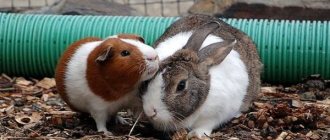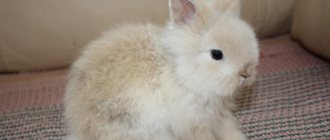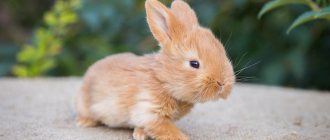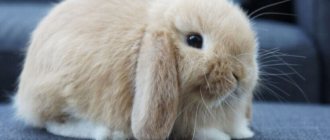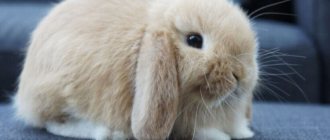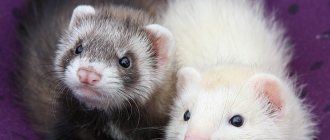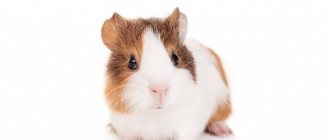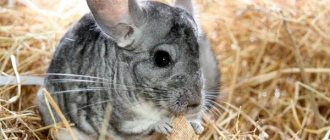Rabbit or chinchilla.
Who do you recommend - a chinchilla or a rabbit? And why? What to look for when choosing an animal? Who has at least one of these cute creatures? Who is more difficult to care for? Or just why did you choose him?)) I would be grateful to all the experts who responded, since there have never been such animals) There were only dogs, cats, parrots, fish)))
Published January 31, 2021, 6:11 pm
Naytsikavishe - at auction. Odyag ta vzuttya vіd 10 UAH!
I'm for the chinchilla. Both in terms of intelligence and in terms of smell
Neither am I for them)) we had a chanchilla Bonya.
There was no smell at all during timely cleaning. Not fussy about food.
It seems to me that a rabbit is easier to care for and unpretentious in food. A friend of mine had a couple of chinchillas, he raised them for his wife’s fur coat))) so the food is special, and they are very gentle, they didn’t live long with him
For my wife's fur coat. poor things(((They seem to eat feed and hay. They probably get sick often
We have a Rabbit - I hold it in my arms, but not for long. Of the rabbits, it is better to take a boy, they say girls are more aggressive. He often asks to eat at night. We let him out to run, but I make sure there’s nothing wrong with the grizz. Before the rabbit, the guinea pig lay nearby and the children carried it in their arms. And more vegetables and fruits are allowed than for rabbits. My sister has 2 chinchillas, but it’s hard to hold in her arms.
Chinchillas also run and lay there somewhere.
Shush can be trained not to shit anywhere.
I scold the rabbit and poke it with its nose. It happens occasionally) As you train it.
We had a rabbit, as soon as I remember, I’ll shudder (((Until 6 months everything was ok, then puberty started and he became sooooo aggressive ((( bit the child’s leg, wouldn’t go into his arms anymore, hissed at everyone, chewed corners, wires and hoses from the washing machine.
It’s a pity to keep a chinchilla in a cage(((, I saw it with friends((if there is a lot of private house and space, then yes, you can make it like an enclosure, otherwise it looks like abuse of an animal(((
If the cage is spacious and high, then everything is fine.
No one. Better already a cat. Krol lived for 8 years. At first it was normal. But old age, as they say, is not joy((((hay everywhere, cleaning the cage every day. Then he began to walk under himself, everything is always wet((((smell accordingly ((( Chinchilla is the same + sand everywhere.
I put the sand in the cage, just like it was bought, then I remove it.
The chinchilla is very noisy at night, he needs a separate room. He chews everything, wires, wallpaper, doors, you need to be careful when you let him out.
I agree, at night it makes noise and can scream, well, mine screams sometimes. Lives in the kitchen
Chinchilla is a nocturnal animal! And the rabbit is daytime! The difference is in square meters!
Maybe off topic, but I'm for the rat. Smart, playful, omnivorous
FISH! A little over a year ago, we also really wanted to please the child and buy an animal. I also had my doubts about a rabbit or a chinchilla for a long time. I read a bunch of forums, thought and decided for a long time. The chinchilla was discarded after we found information that they can hardly stand the heat, 25 is already too much for them, and in our apartment with the radiators turned off in the winter, only in severe frosts does it get less than 25. And in the summer, with open windows to the north-west, it is still hot, the windows are all on one side. In general, we decided on a rabbit. I will never own another animal again. This cute animal touched us for the first month. And then, during its walks, it began to gnaw on everything it could reach, including us (you’re sitting at the laptop, not touching anyone, but it comes up from behind and gnaws at the back of your neck! - do you know how painful it is?), wallpaper everywhere, all the cords, everything that was wrong lay there. And yet, yes, the house is cleaned every day, there is a lot of shit per day, it stinks despite all the stuff in the pot. Moreover, it is better to place the pot so that he sits on it when he eats - because there is a rectum there - as soon as he eats, he immediately puts it on. Although there is quite a lot besides the pot. In general, we gave her (she was a girl) to a private home; our three-ruble ruble was not enough for her. Take the advice of experienced people, get some fish))))
Choosing a hamster or baby rabbit for a child
Pet rodents are owned no less often than dogs and cats. For a child, these “fluffy lumps” can become excellent friends if you know the character of the animal. “Sloboda” has prepared a kind of “guide” to rodents: read and choose!
Evgenia Basova and her rabbit Stepashka: “The rabbit is decorative, but I really love it!”
Andrey Dremizov.
| It just seems that getting a rodent is easy: go to the market and buy it. But it is precisely this position that gives rise to a bunch of problems, says the owner of a specialized store, Karina Sargsyan : “Before going to the store, you must answer several questions: |
— Does your child have an allergy to animals?
— Will the child be able to take care of the animal himself (you definitely won’t have time)? — Will the child be able to play with it? — How much will it cost to keep the animal? There are many more points, but these are the most important. The rodent must “match your home,” and you need to take everything into account: how the animal smells, how it eats, how it moves (there are “night” animals, and there are “daytime” ones). If the child has already made a choice (“I want a hamster!”), he must be introduced to the animal in absentia: the child must know, for example, that it is impossible to squeeze the animal - hamsters do not tolerate this well and may die. Is your child very sensitive? Then you need to choose a long-lived animal. Do you often go on business trips? Then you better not take a rabbit... And NEVER keep hamsters.
Our reference Personal files of rodents
| Rat Price: from 100 rub.; maintenance: 50–60 rub./day; lives: 2–4 years; cleaning: 2 times a day. Pros: smart, trainable, affectionate to the owner, omnivorous, easy to care for, you can take her for walks and visit her. Cons: has a smell, can cause allergies, requires constant attention, tries many things by heart. |
| Hamster Price: from 100 rub.; maintenance: a little more than 1 rub./day; lives: 1.5–2 years; cleaning: once a week. Pros: affectionate to the owner, weak smell, emotional, playful, does not shed. Disadvantages: bedding or food can cause allergies, needs a varied diet and a durable cage, does not tolerate “hand” petting and street walks, sleeps during the day. Attention! Hamsters “can’t see” heights, so they can fall to their death. |
| Chinchilla Price: from 4500 rubles; maintenance: 50–60 rub./day; Lives: 18–35 years; cleaning: once every two to three weeks. Pros: does not smell, is smart, guesses the owner’s wishes, does not shed, there are no fleas and ticks, can be given to children: is not afraid of “squeezing”, does not cause allergies. Cons: does not like noise, is active at night, expensive to maintain, chews wires and furniture. |
| Decorative rabbit Price: from 1000 rubles; maintenance: 50–60 rub./day; lives: 7-8 years; cleaning: once every three days. Pros: very emotional and sweet, amenable to training, no special smell, you can walk outside. Cons: requires careful care, is active at night, expensive to maintain, chews wires and furniture, is reluctant to be handled. Attention! Rabbits should never be picked up by the ears! |
| Guinea pig Price: from 450 rubles; maintenance: 50–60 rub./day; lives: 5-8 years; cleaning: 2 times a day. Pros: she is very emotional and sweet, she can be trained, she allows herself to be petted and picked up, you can walk with her on the street and play. Cons: requires careful care, can bite and scratch, is expensive to maintain (a cage and the need for fresh greenery), chews wires and furniture. |
| Degu (squirrel) Price: from 700 rub.; maintenance: 50–60 rub./day; lives: 8–10 years; cleaning: once a week. Pros: high intelligence: responds to a nickname, does not emit odors, is easy to care for, allows itself to be petted and picked up, you can walk with it on the street and play. Disadvantages: he is noisy, requires a special cage with a wheel, requires steam, gets bored alone, chews wires and furniture. Attention! Meat is contraindicated! |
| Chipmunk Price: from 5000 rub.; maintenance: 50–60 rub./day; lives: 8–10 years; cleaning: 2-3 times a week. Pros: he can be trained, does not emit odors, allows himself to be petted and picked up, you can walk with him on the street and play. Cons: noisy, requires a special cage with a wheel, requires a pair: gets bored alone, chews wires and furniture. Attention! Meat is contraindicated! |
| Ferret Price: 3000-15000 rub.; maintenance: 50–60 rub./day; lives: 8–12 years. Doesn't live in a cage, but goes to the litter box. Pros: amenable to training, emits a light pleasant smell of musk, allows himself to be caressed and picked up, sociable: you can walk with him on the street and play. Cons: may cause allergies, requires special nutrition, may break or break something, ferrets need to be vaccinated annually. |
By the way, there lives a rat mouse in Tula!
A hybrid of a rat and a mouse lives with Tula veterinarian Olga Chernikova :
| – In nature, such a hybrid is impossible: a rat and a mouse are different animals. In laboratories, such a hybrid is produced for experiments on the study of hereditary human diseases - the project was closed, and the animals were ordered to be euthanized. Zhorik was brought to me by my colleague from Moscow, who decided that the animal, which had served humanity for several months, testing drugs for the treatment of cancer, deserved a better fate... |
Dear readers!
Maybe you have questions for your veterinarian? Call 33-64-50 or write to [email protected] .
Correspondent Galina Kuzina.
Rabbit & chinchilla: choosing a pet
“Which should I get, a rabbit or a chinchilla?” This question is often asked by people who want to get a new pet. To help you make your choice, let’s now compare these charming fluffies according to the most basic parameters.
Smell and tray
The main factors of interest to a person planning to get a pet. Chinchilla doesn't smell. In the cage he chooses one corner for the toilet, washing which completely eliminates unpleasant odors from feces. When moving around the apartment, he can shit anywhere. There is a smell from the rabbit. The tray and cage will have to be washed regularly, sometimes 2 times a day. But the rabbit easily gets used to the tray, into which it runs while walking around the room.
Health and hygiene
Both rabbits and chinchillas react poorly to drafts and temperature changes, as well as loud, sharp sounds and smells. The rabbit needs to be regularly bathed, combed, and its claws trimmed. The chinchilla bathes in special sand in a special bath; no other care for its coat is required. If a rabbit gets sick, it is easier to cure - veterinarians deal with them tens of times more often than with chinchillas. In addition, there are vaccines for rabbits that help avoid many diseases.
Character and behavior
It is difficult to hold and pet a chinchilla. But unlike the affectionate rabbit in this regard, she will not become aggressive during puberty and hunting. The rabbit can be carried in your arms, stroked and scratched, the big-eared one will be delighted with this. Willingly take part in children's games and make friends with a cat or dog. Until he grows up, he will be sweet and affectionate. And then an increase in aggression is possible: the rabbit will attack, scratch, bite. The changes in the behavior of female rabbits become especially sharp.
Diet
Both species are considered problem-free in nutrition. Grass, hay, grain mixtures, fruits and berries - the animals’ diet is almost identical. There are no sharp differences in one direction or another.
Ease of maintenance and walking around the apartment
Both animal species require cages. An inexpensive standard cage is suitable for a rabbit, but a chinchilla cage requires a special one and is not cheap. Given nighttime activity, the cages are located away from the bedrooms. And while a rabbit can be trained not to make noise at night, this trick won’t work with a chinchilla. The cute creature puts on such nightly concerts that there may be complaints from neighbors. The disadvantages of a rabbit include peeled wallpaper, chewed wires, damaged furniture, and smelly urine marks. Although the chinchilla does not refuse the opportunity to sink its teeth into everything that catches its eye. In addition, it easily squeezes into the narrowest cracks, which can lead to unpredictable results.
Let's summarize: If you have the opportunity to devote a lot of free time to an animal, a rabbit is suitable for you. You can play with it and walk with it, taking it out on a harness, the rabbit can be trained - the animal easily masters simple tricks. If the absence of odor and a minimum of fuss with cleaning the cage are more important to you, get a chinchilla. Watching the jumps and games is also a pleasant pleasure. But all her walks around the apartment must be under strict control.
Subscribe
to our channel and read new articles, blogs and topics daily.
Our VKontakte and Facebook pages. There are also a lot of interesting things there!
Some images on our channel are taken from open sources, Yandex Images and social networks.
Source
SILVER CHINS
When choosing a main activity, potential farmers often have the question of whether it is more profitable to raise a rabbit or a chinchilla. Due to the fact that both rabbits and chinchillas belong to the order of rodents, their maintenance involves many common points. However, in practice there are large differences both in the content and in the implementation of the final product.
So which is more profitable?
There is no clear answer to this question. But in order to understand what is easier for a novice farmer to implement based on his available capabilities, he needs to compare a chinchilla and a rabbit in various aspects of keeping and only then, after conducting a comparative analysis, can the final choice be made. We will try to impartially consider all the + and - contents of both rabbits and chinchillas.
Received raw materials
Rabbit
The main direction of rabbit breeding is, of course, the sale of their dietary meat.
+ Meat breeds of rabbits gain animal weight very quickly and by 4 months can weigh about 4 kg and are ready for slaughter or further breeding. At the same time, the yield of pure meat from the total weight reaches 70%.
+ In our market, rabbit meat is not considered a curiosity and, at an adequate price, is in demand and quite successfully sold.
+ There are also downy breeds of rabbits. One animal can produce about 1 kg of fluff per year. The price of down from ordinary rabbits costs around 1000 rubles. for 1 kg. but the down of Angora rabbits is already estimated at around $130, which at today’s exchange rate is about 10,000 rubles. The down of Angora rabbits does not require additional processing and is actively used in the textile industry.
Previously, rabbit skins were in demand, children's fur coats were made from them en masse, but at the moment the skins most often remain unclaimed and are burned. The only exceptions to this can be the skins of some color mutations of the Rex breed and rabbits of the Orylag breed. There are several reasons for this: Meat rabbits are slaughtered before their fur finally matures. On average, the skin is formed only by 6 months; the costs of maintaining a rabbit for an extra two months do not cover the income from the sale of their skins. The cost of processing rabbit skins with modern chemicals often exceeds the cost of the skin itself. Dressing using “old-fashioned” - artisanal methods is already morally outdated and does not provide the modern level of quality of fur. Large factories are extremely reluctant to take on the processing of rabbits, since the abundant hair that falls out during the dressing process clogs the water treatment system at the factory. The only way out of this situation is to manufacture fur yourself with further tailoring and sale of finished fur products. But in light of recent events with mandatory microchipping of all fur products, hardly any farmers will dare to do this.
— Rabbits can also be bred and sold as breeding and ornamental animals. But considering this as the main income from the farm would be reckless. This is more suitable for home breeders or small nurseries.
Chinchilla
— Chinchilla meat is dietary and is used for food. Its cost is quite high, but unlike rabbit in our market it is still exotic and finding constant sales and sale of chinchilla meat as a commercial product is extremely problematic.
— Comparing a rabbit and a chinchilla in terms of meat productivity is the same as comparing chicken and quail. From one chinchilla you can get only 200 - 300g of meat.
— Chinchilla fluff is also highly valued, but it is also unlikely to create a separate business in this area, due to the too small volume of its collection. At best, this can be as additional income on a farm with a large number of animals.
— The chinchilla farm generates its main income through the sale of skins from this animal. But there are a lot of pitfalls here. Currently, Russian fur factories do not have the technology for processing the fur of this rodent, and without this it is impossible to sell skins ready for sewing on the domestic market. There are also many difficulties with the export and sale of dry skins abroad. In addition, the quality of animals offered for sale in Russia, to put it mildly, leaves much to be desired.
— The chinchilla has been bred and sold as an ornamental animal for a long time, especially with regard to various color mutations. But at the moment, this business has already outlived its usefulness and you should not expect a constant and stable income from it. The idea of selling fur chinchillas of a standard color as breeding breeders could perhaps become quite a profitable business, but unfortunately, without a fur farm, with constant strict selection and culling, it will also be doomed to failure over time.
Care and maintenance
Rabbit
+ The conditions for keeping rabbits in Russia have been well studied and have a wealth of scientific experience. There are several different housing systems, including outdoor ones. That is, in a zone with a temperate climate, rabbits can be kept even without permanent structures.
+ Rabbits are very fertile and are capable of producing up to 10 young rabbits per lamb. In a year, one female can produce up to 40 children.
+ Rabbit feed is inexpensive and is available in feed mills throughout the country. The diet is much simpler and more affordable than that of chinchillas.
+ Unlike chinchillas, rabbits are calmer animals, they do not splash urine, do not chew everything they can reach and do not throw out half of the feed from the feeder.
— Rabbits are quite voracious and feeding is perhaps the main expense item on the farm. An adult rabbit consumes up to 150g of feed per day.
— Another problem for all rabbit breeders is various epidemiological diseases that can wipe out the entire herd within a few days.
— Rabbit waste is quite “fragrant.” You need to choose a place for a farm, taking into account the fact that with a limited area, you can easily make enemies from nearby neighboring houses.
Chinchilla
+ In the USSR, chinchilla was studied in the 60-70s of the last century, but there are no established technologies for building chinchilla farms in Russia yet. However, fur farms have existed in European countries for more than 50 years. And over the years, we have accumulated quite a wealth of experience in keeping and breeding chinchillas on fur farms. Therefore, in order not to mess things up, the best thing to do is turn to your European colleagues for experience in setting up a farm.
— To maintain a chinchilla fur farm, a permanent structure is required with mandatory ventilation and a system for maintaining temperature and humidity in the farm premises.
— Chinchillas are low-fertile, the average yield of sexually mature young animals on large farms ranges from 2.5 to 4 from one female per year.
— There is practically no production of specialized food for chinchillas in Russia. Rabbit food does not provide chinchillas with all the vitamins and minerals they need. Producing your own food is much more expensive than factory-made rabbit food.
- Chinchillas require much more attention. They happily shoot urine all over the farm, chew and tear off everything they can reach, chew through hoses and throw food out of feeders. There is always a danger of fractures, or they may simply manage to hang themselves on something in the cage.
+ With such an active lifestyle, chinchillas eat surprisingly little; on average, an adult animal consumes about 40g of food per day. This is otherwise compensated by the more complex composition of the feed and its higher content of vitamins and minerals.
+ Chinchillas are also susceptible to many diseases, but the sudden death of an entire herd in a short period of time is still an extremely rare event. Unlike rabbits, chinchillas do not need universal vaccination.
+ Chinchilla urine and droppings are odorless. The smell of ammonia appears only when the urine has already decomposed. In this regard, if the premises are cleaned in a timely manner, the chinchilla farm will not significantly poison the air and annoy the neighbors.
As we see, breeding chinchillas and rabbits are radically different and require different approaches, both in content and in the implementation of the final product, and the final decision, after weighing all the pros and cons, remains only with you.
SilverChins
Guinea pig, rabbit or chinchilla?
There comes a time in every family when growing children want to have a pet. Choosing an animal is not an easy task, especially when parents do not have time to walk it, and the child himself cannot yet fully take on the responsibilities of maintaining a pet.
The solution is to buy a small rodent. He lives in a cage, can go for walks right in the apartment, and spending the day alone is not a big problem for him.
Each animal has its own advantages and disadvantages. Knowing them will help you make the right choice.
Rabbit
Many people like kittens, but they are often allergic to them, and therefore a tiny rabbit can be an alternative - representatives of decorative breeds can easily fit in the palm of your hand and weigh around one and a half kilograms. And you can really play with it: rabbits are very mobile, and therefore need daily walks around the room.
Aggression is not typical for these animals.
The advantages include the following:
- rabbits are easy to litter train;
- they do not make noise at night and behave calmly most of the time;
- It is easy to keep order in their cage.
These rodents are demanding when it comes to food, but if you provide them with hay, grass and twigs in a timely manner, and also buy the necessary mineral and vitamin supplements, there will be no problems with feeding. The same applies to health - regular vaccinations and visits to the veterinarian will protect animals from infections.
One of the disadvantages is excessive mobility - children cannot always hold the rabbit in their hands. In addition, animals have a tendency to chew on something if left unattended during a walk. Also, the decorative rabbit requires timely cleaning of the cage and tray. He will have to be fed frequently and ensure that there is always clean water in the drinking bowl.
Chinchilla
The chinchilla in the photo seems to be a very beautiful, cute and harmless little animal that you want to pet. In reality, it's not that simple.
Chinchilla is a capricious animal. She needs constant care and good conditions - this is an additional financial expense. Children from 10–12 years old will be able to fully care for a rodent. Otherwise, parents will have to take on most of the care of the animal.
The animal needs a lot of space, so it is better to buy a large cage. Chinchillas are quite nimble, so the distance between the bars should be such that the mouse does not accidentally jump out. You can and should let her out for a walk, but you should carefully ensure that the pet does not hide somewhere under the sofa, otherwise it will take a long time to find him.
It is also worth taking into account the fact that the chinchilla is a nocturnal animal, which means you will have to get used to its constant wakefulness in the dark. Although there is a plus to this - during the day the rodent sleeps more, and in the evening, when the whole family gathers, it begins to be active. This is the best time to play with your chinchilla and pick it up.
This animal also has other advantages. Chinchillas do not smell at all because they do not have sebaceous glands. They are interesting to watch if they are in a good mood. Although a child with a chinchilla needs to be careful: it can easily bite.
Guinea pig
Many people are attracted to the guinea pig not only by its appearance, but also by its interesting name. The cute little animal is constantly on the move. Therefore, pigs sometimes cause a lot of noise and fuss. But she loves to sit in her arms - in this regard, the animal is quite capable of replacing an affectionate kitten. That’s why children like these rodents more.
Mini-pig, chinchilla or dwarf rabbit: which one to choose?
Mini pigs are ordinary pigs, only very small. They were bred in the 50s of the last century by German scientists for experiments on transplanting pig organs to humans. But the experiments were unsuccessful, but pigs unexpectedly became very popular pets.
This is not to say that mini pigs are very small. Some of them reach a weight of 120 kilograms. But a real big pig can weigh about half a ton! Therefore, if you keep piglets in the house, then only dwarf ones. True, caring for them is quite difficult.
The mini-pig is a very smart, funny, affectionate creature. But the pig is very energetic and restless, she loves to taste everything. Therefore, be prepared for the fact that the pet will cause damage not only to your shoes, which are not put away in a timely manner in a distant cabinet, but also to linoleum or plasterboard partitions.
It is best to feed mini pigs with cereals, vegetables, dairy products and fruits. It is hardly possible to train pigs to go to the litter box, so you will have to walk the pigs regularly. They also have a specific smell and make a lot of noise. But will such little things stop true exotic lovers?
Chinchilla is a very beautiful fur-bearing animal. She has gorgeous fur and adorable sad eyes. Having seen such a creature, it is difficult to resist and not turn on it. Fortunately, although the animal comes from South America, it gets along well in our climate and is quite unpretentious.
The chinchilla is a nocturnal animal, so be prepared not to disturb your pet during the day when he is sleeping. Chinchillas are fed special food. Which is sold in pet stores, as well as hay, grass and fruit. The animal does not tolerate heat well; at a temperature of 25 degrees it can get heatstroke. For your pet, you need to prepare special sand in which the chinchilla will bathe. She also needs constant physical activity. Therefore, you need to buy a wheel at a pet store.
The dwarf rabbit is a fairly easy pet to keep. He is cheerful and sociable, he cannot be kept in a cage, he must be allowed to run around the apartment like a cat. The mini rabbit is a typical rodent, so it will constantly chew on everything. But this animal is very smart and affectionate, it can even be taught to go to the toilet in a tray.
Rabbits are fed special food and grass, hay, and any plant food. They can be walked outside on a special harness. But under no circumstances should you take these creatures by the ears, and in general, they do not like to be held.
In any case, it’s up to you to decide what kind of pet to get. Be guided by your own inclinations and common sense. Think carefully again: maybe it’s better to bring an ordinary kitten into the apartment?
Rabbit or chinchilla?
Rabbit or chinchilla?
Unread message by kora » 03 Mar 2013, 23:45
Re: Rabbit or chinchilla?
a couple tells me that if an animal is gray in a cage, then the stench will be unmistakable and it doesn’t matter who is in the cage, especially since he’s been at work all day
I think rabbits are more susceptible to careful grooming, they die in vain, God forbid there is a draft, vaccinations are required
As for chinchillas, I don’t know anything about them, I just saw that they are expensive and infectious
Re: Rabbit or chinchilla?
Re: Rabbit or chinchilla?
Unread message NFO » 04 Mar 2013, 05:26
Re: Rabbit or chinchilla?
Re: Rabbit or chinchilla?
Decorative rabbit - character depends on the breed (Similar to dogs/cats). Personally, I give my preference to dwarf fold-eared rams - although they have slightly greater parameters than other dwarf ones (I can advise where to get a baby rabbit from medium-sized parents - 1200-1400 with a soft character), but the character is sociable, not harmful. Contact dogs are well accustomed to order (toilet and other hygienic procedures and the need to chew on anything/wherever), they know their name and are very affectionate. I have never observed males of this breed marking territory - a huge plus. Active during the day, activity at night is rather an exception. Often kept without cages (As a small rabbit grows up, it must be kept in a cage). They are unpretentious when it comes to food, but they have their own nuances. There is no need to walk the streets - accordingly, the risks of contracting an infection are minimal. They only suffer from their own (rabbit) diseases (with the exception of skin diseases). In general, in terms of maintenance and care, they are in many ways similar to cats/dogs.
Chinchilla. Independent and hyper-active. Night animal. Letting him go for a walk requires constant monitoring - it will not be possible to wean him from gnawing and sharpening the necessary things and furniture. A very cute and funny animal. Contact with water is strictly prohibited (drinking only, in automatic drinkers), they bathe in special sand, do not give wet food, and are fed only with special feed mixtures. Walking outside is also not necessary; a cage is required and a tall, multi-tiered one is desirable.
The excrement of decorative rabbits and chinchillas does not have a distinct odor, and the wool also does not have any specific odors. The starting costs for a chinchilla are several times higher, but further maintenance costs are approximately the same. Neither chinchilla nor rabbit requires pairs. To make a choice about who you need, you first need to decide what you want to get from the animal? And buy a young animal.
Source
